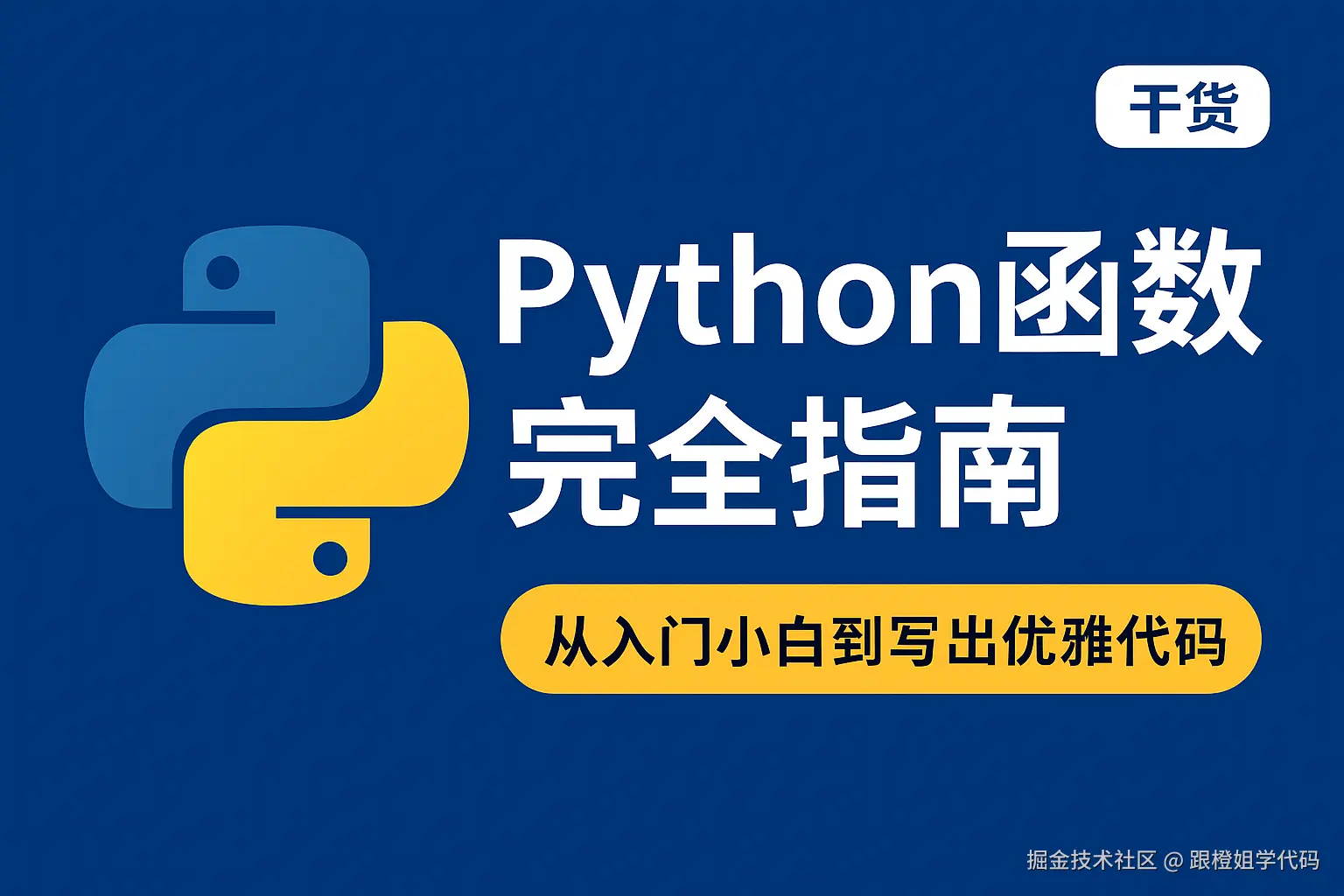在学 Python 的过程中,你会发现一个有趣的现象:不管是写小脚本,还是做大项目,函数几乎无处不在。 如果说变量是程序的"砖瓦",那么函数就是"积木模块"。学会函数,就像学会了把零散的砖瓦搭建成房子。
很多新手学到函数时,脑袋里可能会冒出这样的疑问:
- 函数到底是干啥的?
- 我写 print() 打印也能跑,为什么要费劲定义函数?
- 函数里面那些参数、返回值、作用域看着有点绕,到底该怎么理解?
别急,这篇文章会带你从基础到进阶,一口气把 Python 函数的精髓讲清楚。文章比较长,但读完你会对函数有个全面认知,足够应付大多数开发场景。

1. 函数是啥?
一句话解释:函数就是帮你把代码"打包"起来,想用的时候直接拿出来调用。
想象一下:如果你每天都要写一百遍 print("hello world"),是不是很麻烦?这时候你就可以定义一个函数,把"打印 hello world"的逻辑放进去,后面只要写函数名,代码就能跑,既省事又干净。
python
def say_hello():
"""打印问候语"""
print('hello world')
# 调用函数
say_hello()
say_hello()输出:
hello world
hello world这就是函数最朴素的意义:把重复的逻辑抽出来,提高复用性。
2. 参数的魔力:让函数更灵活
光打印 hello world 显然没啥意思。函数真正的威力在于它可以接收"参数",让逻辑变得灵活。
python
def greet(name):
"""向指定的人问好"""
print(f'Hello, {name}!')
greet('Alice')
greet('Bob')输出:
Hello, Alice!
Hello, Bob!这就像你点外卖时给备注:
- 说"加辣"就是一个参数;
- 说"不要葱"也是一个参数。
函数的参数,正是让逻辑根据输入而变化的关键。
3. 深入理解函数的"参数系统"
Python 的函数参数有点小门道,新手经常被坑。咱们一条一条拆开讲:
3.1 位置参数
按照顺序把值传给函数,叫位置参数。
python
def describe_pet(animal_type, pet_name):
print(f"I have a {animal_type}.")
print(f"My {animal_type}'s name is {pet_name}.")
describe_pet('hamster', 'Harry')输出:
css
I have a hamster.
My hamster's name is Harry.3.2 关键字参数
懒得记顺序?直接写上参数名就行:
ini
describe_pet(pet_name='Harry', animal_type='hamster')效果完全一样。
3.3 默认参数
有些参数常用值差不多,干脆给它一个默认值。
python
def describe_pet(pet_name, animal_type='dog'):
print(f"I have a {animal_type}.")
print(f"My {animal_type}'s name is {pet_name}.")
describe_pet('Willie') # 不写 animal_type,就默认是 dog结果:
css
I have a dog.
My dog's name is Willie.就像点奶茶默认是"半糖",除非你主动说"我要全糖"。
4. 返回值:函数的"输出口"
如果函数只能打印结果,那未免太局限了。更常见的需求是:函数做了计算,把结果返回出来,供后续代码使用。
4.1 返回单个值
python
def add_numbers(a, b):
return a + b
result = add_numbers(3, 5)
print(result) # 84.2 返回多个值
Python 里返回多个值很常见,其实是打包成了一个元组。
ini
def get_name():
first = 'John'
last = 'Doe'
return first, last
first_name, last_name = get_name()
print(first_name, last_name)结果:
John Doe5. 高级玩法:*args 和 **kwargs
有时候你不知道要传几个参数,这时候就用可变参数。
5.1 *args ------ 不定长位置参数
scss
def make_pizza(*toppings):
print("Making a pizza with the following toppings:")
for topping in toppings:
print(f"- {topping}")
make_pizza('pepperoni')
make_pizza('mushrooms', 'green peppers', 'extra cheese')5.2 **kwargs ------ 不定长关键字参数
ini
def build_profile(first, last, **user_info):
user_info['first_name'] = first
user_info['last_name'] = last
return user_info
user_profile = build_profile('albert', 'einstein',
location='princeton',
field='physics')
print(user_profile)输出:
arduino
{'location': 'princeton', 'field': 'physics', 'first_name': 'albert', 'last_name': 'einstein'}这就像填简历:前两项是必须的,其它信息随便加。
6. 函数也能"像变量一样玩"
函数在 Python 里是一等公民,能干的事可多了。
6.1 赋值给变量
python
def shout(text):
return text.upper()
yell = shout
print(yell('hello')) # HELLO6.2 当作参数传递
scss
def greet(func):
greeting = func('Hi, I am created by a function')
print(greeting)
greet(shout)这就是函数式编程的雏形。
7. Lambda 函数:匿名的小工具
有时候函数太短,不想大费周章写 def,就用 lambda。
ini
square = lambda x: x ** 2
print(square(5)) # 25
numbers = [1, 2, 3, 4]
squared_numbers = list(map(lambda x: x**2, numbers))
print(squared_numbers) # [1, 4, 9, 16]8. 作用域:变量能活多久?
8.1 局部 vs 全局
scss
x = 10
def my_func():
x = 20
print("局部x:", x)
my_func()
print("全局x:", x)结果:
makefile
局部x: 20
全局x: 108.2 修改全局变量
ini
x = 10
def modify_global():
global x
x = 20
modify_global()
print(x) # 209. 装饰器:优雅的"外挂"
装饰器本质上就是函数套函数,可以在不修改原函数的前提下,给它加点"前戏"和"后戏"。
python
def my_decorator(func):
def wrapper():
print("装饰器: 在函数调用前执行")
func()
print("装饰器: 在函数调用后执行")
return wrapper
@my_decorator
def say_hello():
print("Hello!")
say_hello()10. 实战案例
10.1 小型计算器
python
def calculator(operation, a, b):
if operation == 'add':
return a + b
elif operation == 'subtract':
return a - b
elif operation == 'multiply':
return a * b
elif operation == 'divide':
if b == 0:
return "Error: Division by zero"
return a / b
else:
return "Error: Invalid operation"
print(calculator('add', 5, 3)) # 8
print(calculator('divide', 10, 2)) # 5.0
print(calculator('power', 2, 3)) # Error: Invalid operation10.2 用户验证
python
def validate_user(username, password):
if len(username) < 4:
return False, "用户名至少需要4个字符"
if len(password) < 8:
return False, "密码至少需要8个字符"
if not any(c.isdigit() for c in password):
return False, "密码必须包含数字"
return True, "验证成功"
result, message = validate_user("admin", "password123")
print(result, message)结语
函数在 Python 里的地位,就像发动机之于汽车。没有函数的代码,迟早会乱成一团;善用函数的代码,却能清晰、可维护、还容易扩展。
从最简单的封装,到高阶的装饰器、lambda,函数不仅仅是语法工具,更是一种思维方式。掌握函数,你才算真正跨入了 Python 的大门。